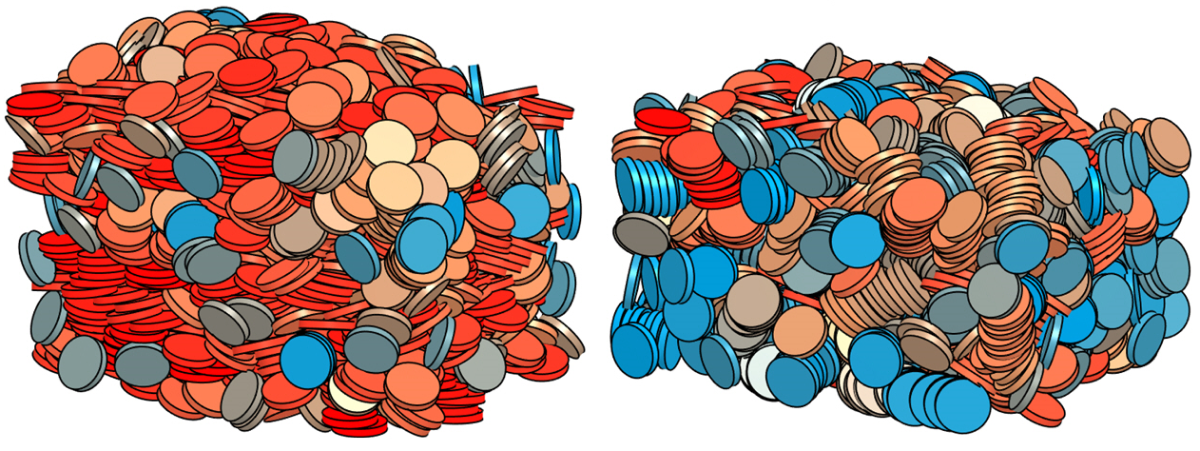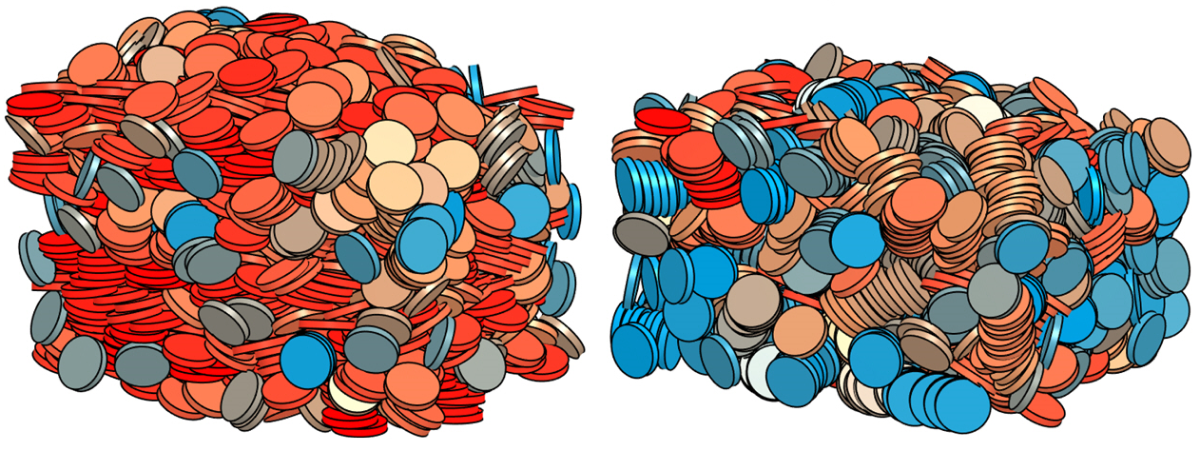Packing Disks in a New Way
From liquid crystals to bags of coins and bottles of pills, how disk-shaped objects pack together is a question with wide relevance in science and technology. In experiments on coin-sized plastic disks, researchers have found a new type of packing behavior in which the disks form short stacks that jam up against one another, preventing long-range alignment [1]. The researchers predict that structures like these might be formed in molecular and mesoscale materials such as liquid crystals and clays, where they could influence the mechanical, flow, and optical properties.
Disk particles can arrange in a variety of possible packings, depending on temperature, density, and other parameters. The flat molecules in discotic liquid crystals, for example, are observed in equilibrium arrangements that include a nematic phase (where the disks are oriented in the same direction but otherwise disordered, like coins loosely piled in a dish) and a columnar phase (where the disks are neatly arranged in parallel stacks). But other nonequilibrium arrangements might be possible. In particular, for mesoscale aggregates of plate-like particles such as clays, the effects of temperature become insignificant, as friction locks particles into structures dictated largely by geometry.
Physicists can study packing behavior directly by using relatively large particles that can be imaged with magnetic-resonance imaging (MRI) [2, 3] or x-ray tomography. Most previous experimental studies of such macroscopic granular systems have been performed on spherical or rod-like particles, but Chengjie Xia and colleagues from the East China Normal University have now used MRI to look at the configurations of plastic disks confined within rectangular containers.
The disks, measuring about 3 cm across and 5 mm thick, were hollow and filled with a gel that produces a strong MRI signal, allowing their positions and orientations to be deduced throughout the container. The researchers used around 1200 disks in each packing, although they only focused on about 500 in the center of the container where the effects of the walls were considered negligible. After filling the container, the researchers allowed the disks to settle by repeatedly dropping the container to the ground from a height of about a centimeter. This procedure gave them some control over the packing density.
In general the disks showed a degree of mutual alignment, as in a nematic discotic liquid crystal. But Xia and colleagues were surprised to find that the amount of overall alignment decreased as the disks became more densely packed. One might intuitively expect the opposite: that denser packings only become possible because of greater alignment of the disks, leaving less free space. This trend was indeed observed in an earlier experimental and theoretical study of packings in clays [4].
To understand the unexpected packing behavior, Xia and colleagues examined the internal arrangement more closely and found that the disks form small, slanted-cylindrical stacks, one atop the other. But despite this local alignment, the stacks themselves are randomly oriented—so the average orientational correlation of the disks is small compared to a nematic arrangement. “The stack structures kill global orientational order due to the weak correlation between neighboring stacks,” says Xia. The arrangement that they see is similar to a “cubatic” phase predicted in earlier simulations [5, 6] and seen experimentally in clays [7]. However, the relation between the observed phase and the cubatic phase is not yet clear.
Although in principle the stacks could move and rotate as a whole to produce a dense columnar arrangement like a stack of logs, in practice they seem to get jammed into this disordered state. The researchers suspect that, with more intense shaking, it may be possible for the system to undergo a transition to a globally aligned columnar state, as has been seen in simulations [6].
The new stacking state could prove useful in producing porous materials, Xia says. For example, the amount of porosity in a permeable concrete could be controlled by using disk-like particles of a particular shape in the preparation process.
“What is neat about this work is how the authors can explain [their results] by the occurrence of stacks of disks and can show how such stacks might come about,” says Heinrich Jaeger, an expert on granular media at the University of Chicago. He found the results unexpected, at least at first glance. “Intuitively I might have thought that with increasing packing fraction the disks would have to align more with each other”—as seen in the earlier study on clays [4]. He suspects the apparent discrepancy might be partly due to differences in how the disk and clay materials are prepared, which might result in different types of packing structures in the otherwise similar systems.
–Philip Ball
Philip Ball is a freelance science writer in London. His latest book is How Life Works (Picador, 2024).
References
- Y. Ding et al., “Structural transformation between a nematic loose packing and a randomly stacked close packing of granular disks,” Phys. Rev. Lett. 131, 098202 (2023).
- R. Stannarius, “Magnetic resonance imaging of granular materials,” Rev. Sci. Instrum. 88 (2017).
- E. E. Ehrichs et al., “Granular convection observed by magnetic resonance imaging,” Science 267, 1632 (1995).
- T. Dabat et al., “Mesoscale anisotropy in porous media made of clay minerals. A numerical study constrained by experimental data,” Materials 11, 1972 (2018).
- J. A. C. Veerman and D. Frenkel, “Phase behavior of disklike hard-core mesogens,” Phys. Rev. A 45, 5632 (1992).
- M. Marechal et al., “Frustration of the isotropic-columnar phase transition of colloidal hard platelets by a transient cubatic phase,” Phys. Rev. Lett. 108, 206101 (2012).
- S. J. S. Qazi et al., “Dispersions of plate-like colloidal particles – Cubatic order?” J. Colloid Interface Sci. 348, 80 (2010).







